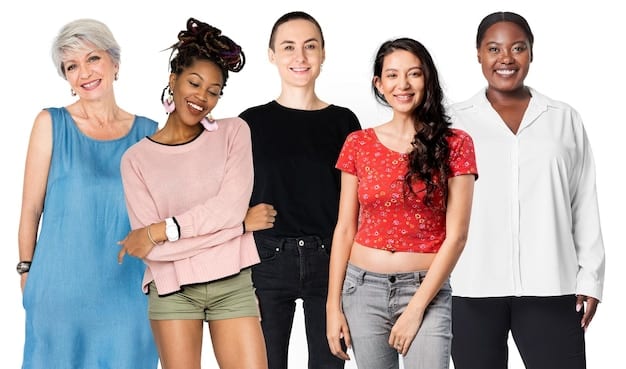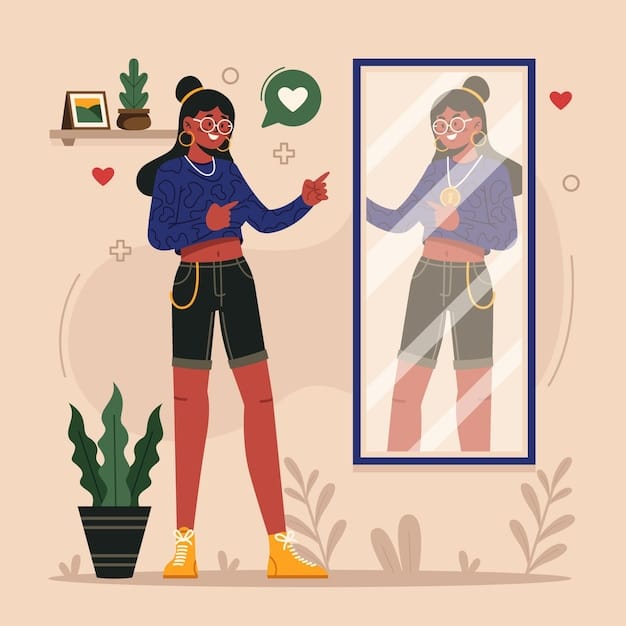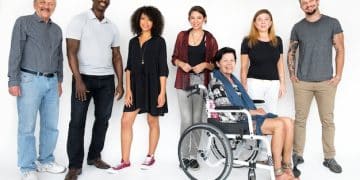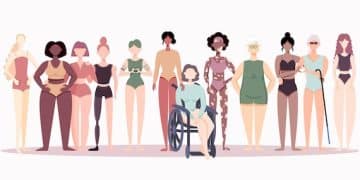Inclusive Language & Body Image: Words That Empower

Advertisements
Inclusive language plays a pivotal role in shaping perceptions of body image by promoting acceptance and diversity, challenging societal norms, and fostering a more positive and equitable environment for individuals of all body types.
Advertisements
The words we use carry immense power, especially when it comes to shaping our perceptions of ourselves and others. When discussing body image, the language we employ can either reinforce harmful stereotypes or promote a culture of inclusivity and acceptance. Understanding the power of inclusive language: how words shape body image perceptions is crucial for fostering a healthier and more positive relationship with our bodies.
Understanding Body Image and Its Influences
Advertisements
Body image is how you perceive your own body, which is more than just how you see yourself in the mirror. It includes your feelings, thoughts, and beliefs about your physical appearance. Numerous factors influence body image, making it a complex and deeply personal experience.
Social Media’s Impact
Social media often presents unrealistic and highly curated images of bodies. This can lead to negative comparisons and feelings of inadequacy. The constant exposure to filtered and edited photos fosters a culture where perceived flaws are amplified, and diversity is often sidelined.
Cultural and Societal Standards
Cultural norms and societal expectations significantly shape what is considered “ideal.” These standards can vary across different cultures, but often promote a narrow view of beauty that is unattainable for many. The pressure to conform to these standards can lead to body dissatisfaction and low self-esteem.
Several elements contribute to forming our body image:
- Family and Childhood Experiences: The comments and attitudes of family members during childhood can profoundly impact how individuals view their bodies.
- Peer Influence: Social circles and interactions with peers can shape perceptions of what is considered attractive or acceptable.
- Media Representation: The portrayal of bodies in media, including television, magazines, and advertising, plays a significant role in defining beauty standards.
Ultimately, understanding the various influences on body image is the first step in promoting a healthier and more positive mindset. By recognizing these factors, individuals can begin to critically evaluate the images and messages they encounter, fostering a more realistic and accepting view of themselves.

The Role of Language in Body Image Perceptions
Language provides the lens through which we interpret and understand the world around us, including our bodies. The words we use when discussing bodies can either reinforce harmful stereotypes and negative self-perceptions or promote acceptance and positivity. The power of language should never be underestimated.
Positive Affirmations and Self-Talk
Using positive affirmations and self-talk can transform internal dialogues. Instead of focusing on perceived flaws, affirmations highlight strengths and promote self-acceptance. This shift in language can lead to a more compassionate and loving relationship with one’s body.
Challenging Fatphobic Language
Fatphobic language perpetuates negative stereotypes and biases against individuals in larger bodies. Terms like “obese” or “unhealthy” can carry judgmental connotations. Instead, using neutral and respectful language promotes inclusivity and reduces stigma. The goal is to describe without prescribing judgment, which can improve overall body positivity and reduce harmful assumptions.
Here are ways language shapes these perceptions:
- Reinforcing Stereotypes: Language that perpetuates stereotypes about body types can lead to discrimination and negative self-perception.
- Promoting Comparison: Comparative language, such as discussing “ideal” bodies, can foster feelings of inadequacy and competition.
- Encouraging Acceptance: Words that celebrate diversity and promote acceptance can help individuals feel valued and appreciated for their unique body types.
By becoming mindful of the language we use, we can actively contribute to creating a more inclusive and accepting society. The messages we send, no matter how subtle, can impact how individuals view their bodies and their overall well-being. Embracing these messages is one way to contribute to positive change.
What is Inclusive Language?
Inclusive language is respectful, unbiased, and aims to avoid marginalizing or excluding individuals or groups based on their identity. It acknowledges diversity and promotes equality by ensuring everyone feels valued and seen. The use of inclusive language is continuously evolving, adapting to changing social norms and heightened awareness of linguistic biases.
Key Principles of Inclusive Language
Inclusive language seeks to diminish the negative impact of language on marginalized individuals and groups. It champions language that’s accessible to all, irrespective of identity or situation. The principles governing it are expansive and multifaceted.
Examples of Inclusive vs. Exclusive Language
Understanding the distinction between inclusive and exclusive language involves recognizing words and phrases that may inadvertently exclude or offend. This starts with acknowledging biases and then adjusting language to uphold respect and equity.
- Person-First Language: Emphasizing the individual rather than their condition. For example, “a person with a disability” instead of “a disabled person.”
- Gender-Neutral Language: Avoiding gendered terms when referring to individuals of unknown or non-binary gender. Using “they/them” pronouns or rephrasing sentences to avoid pronouns altogether.
- Avoiding Stereotypes: Consciously challenging stereotypes by portraying individuals in diverse roles and avoiding generalizations based on identity.
Inclusive language isn’t just about semantics; it reflects a deep respect for diversity and a commitment to equity. By embracing inclusive language, we actively contribute to creating environments where every individual feels welcomed, valued, and understood.

Practicing Inclusive Language in Body Image Discussions
Incorporating inclusive language in conversations about body image involves being mindful and intentional with the words used. It’s about creating a space where everyone feels comfortable, respected, and valued, regardless of their body type, size, or shape. Thoughtful language helps to challenge societal standards and promote healthier attitudes.
Focusing on Health and Well-being
When discussing bodies, shifting the focus from appearance to health and well-being can be transformative. Instead of commenting on weight or shape, conversations can center around energy levels, physical abilities, and overall wellness.
Avoiding Appearance-Based Compliments
While compliments can be well-intentioned, appearance-based comments can inadvertently reinforce societal pressures to conform to specific beauty standards. Instead, focus on qualities like strength, resilience, and character.
Promoting Body Neutrality
Body neutrality encourages acceptance of one’s body without the need for constant positivity. It emphasizes that a body is simply a vessel that allows us to experience life. One way to practice is by moving the focus from appearances to functionality.
Effectively practicing inclusive language encompasses several strategies:
- Using Respectful Terminology: Refer to people’s bodies using respectful and neutral terms, avoiding derogatory or stigmatizing language.
- Highlighting Strengths: Focus on a person’s strengths and abilities rather than their appearance.
- Challenging Stereotypes: Actively challenge and reframe stereotypes related to body image.
By consistently practicing inclusive language, we can make a profound difference in how individuals feel about themselves and their bodies. It requires continuous learning and a commitment to creating a more supportive and accepting world.
The Impact of Media and Advertising
The media and advertising industries hold significant influence over societal perceptions of body image. The images and messages they portray can either perpetuate harmful stereotypes or champion diversity and inclusion. Recognizing the influence is the first step in addressing its impact.
Challenging Unrealistic Standards
The media often presents unrealistic and unattainable beauty standards, created through filters, Photoshop, and other editing tools. This can lead to negative self-comparisons and body dissatisfaction. Challenging these standards involves advocating for more authentic and diverse representation.
Promoting Diverse Representation
Diverse representation in media showcases a variety of body types, sizes, skin tones, and abilities. This helps to normalize the idea that beauty comes in many forms. More diverse representation can help viewers see themselves in what they watch.
Ways this influence shapes perceptions include:
- Setting Beauty Standards: Media sets the tone for what is considered beautiful, which leads to societal pressures.
- Influencing Self-Esteem: Social media contributes to feelings of anxiety and inadequacy, impacting self-esteem.
- Reinforcing Biases: Media messages can reinforce biases related to gender, race, and body size.
Advocating for change in media representation is vital for creating a more body-positive society. By promoting authenticity and challenging unrealistic standards, the media can play a crucial role in fostering self-acceptance and appreciation for diversity.
Creating a Body-Positive Environment
Creating a body-positive environment involves cultivating spaces where individuals feel accepted, valued, and respected for their unique body types and identities. This starts with personal awareness and extends to broader social and cultural changes. A commitment to body positivity can transform communities creating a healthier environment.
Promoting Self-Acceptance
Self-acceptance is the foundation of a body-positive mindset. It encourages individuals to embrace their bodies as they are, without striving for unrealistic ideals. Self-care, boundaries, and positive self-talk can help.
Supporting Others
Supporting others on their body-positive journeys involves offering encouragement, empathy, and validation. It also means avoiding negative comments or judgments about their bodies. This allows for open conversation and support.
Creating the environment includes:
- Practicing Self-Compassion: Be kind and understanding toward yourself, especially during moments of self-doubt or criticism.
- Building Supportive Relationships: Surround yourself with people who promote positivity and acceptance.
- Advocating for Change: Actively advocate for inclusivity and diversity in your community and beyond.
Ultimately, creating a body-positive environment requires a collective effort from individuals, communities, and institutions. By working together, we can foster a culture of respect, acceptance, and appreciation for the diverse beauty of all bodies.
| Key Point | Brief Description |
|---|---|
| 🗣️ Inclusive Language | Using respectful and unbiased terms that promote inclusivity. |
| 💖 Self-Acceptance | Embracing your body as it is, without striving for unrealistic ideals. |
| 📺 Diverse Representation | Promoting a variety of body types in media to normalize beauty standards. |
| 💪 Challenging Standards | Questioning unrealistic beauty standards portrayed in media and society. |
Frequently Asked Questions
▼
Inclusive language is respectful, unbiased language that avoids marginalizing or excluding individuals based on their identities. It acknowledges diversity and promotes equality.
▼
Language shapes perceptions of body image by either reinforcing harmful stereotypes or promoting acceptance and positivity. Positive self-talk and respectful terminology can improve body image.
▼
Diverse representation in media showcases a variety of body types and identities, helping to normalize the idea that beauty comes in many forms and fostering self-acceptance.
▼
Practice inclusive language by using respectful terms, focusing on health and well-being, avoiding appearance-based compliments, and challenging stereotypes related to body image.
▼
Body neutrality encourages acceptance of one’s body without constant positivity. It emphasizes that your body is a vessel that allows you to experience life, shifting focus from appearance to utility.
Conclusion
The power of inclusive language is undeniable when it comes to shaping body image perceptions. By understanding and applying these inclusive ways of communicating, we can cultivate a society that celebrates diversity, promotes self-acceptance, and fosters positive relationships with our bodies.





